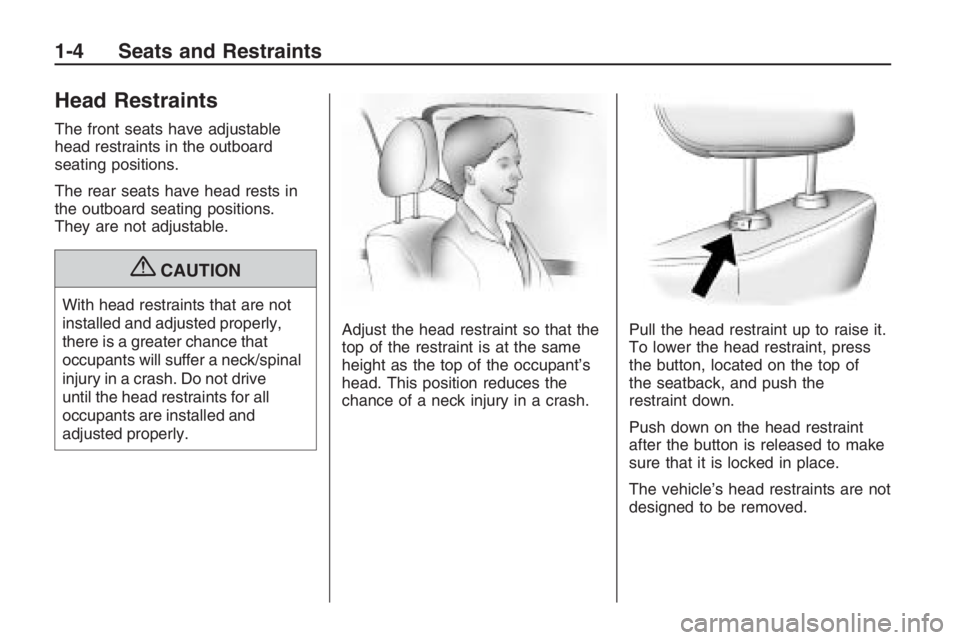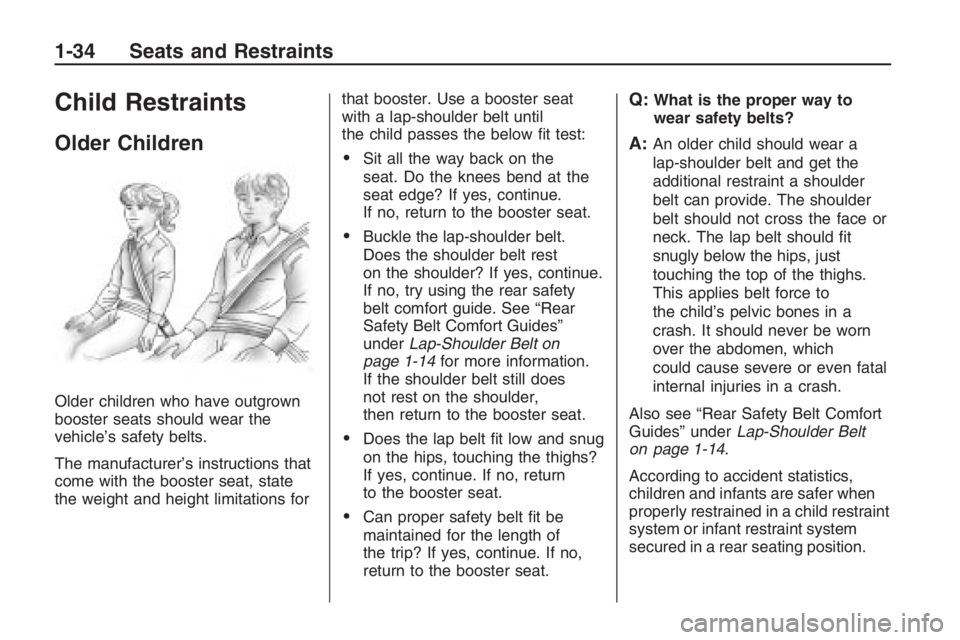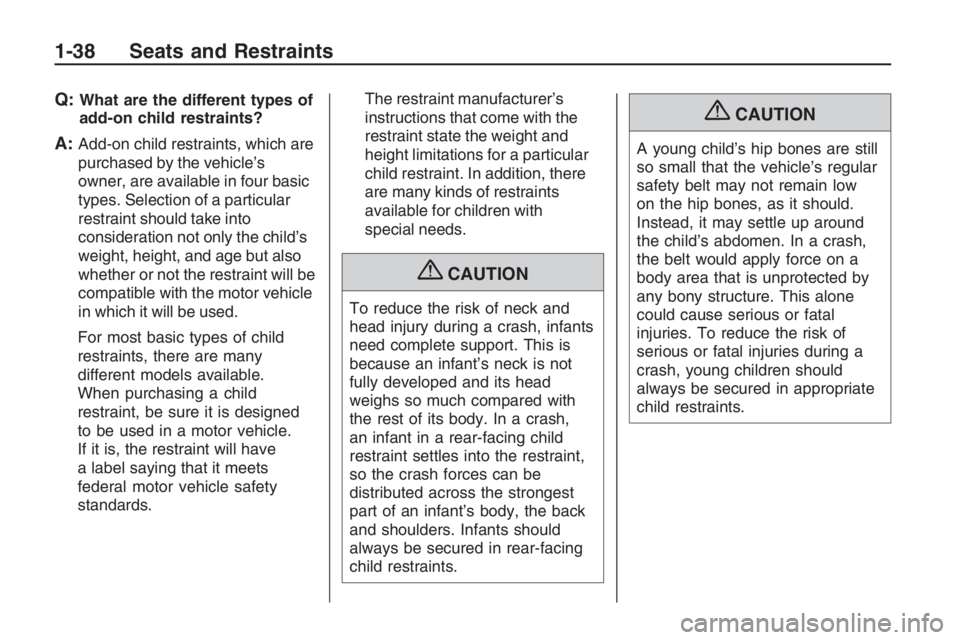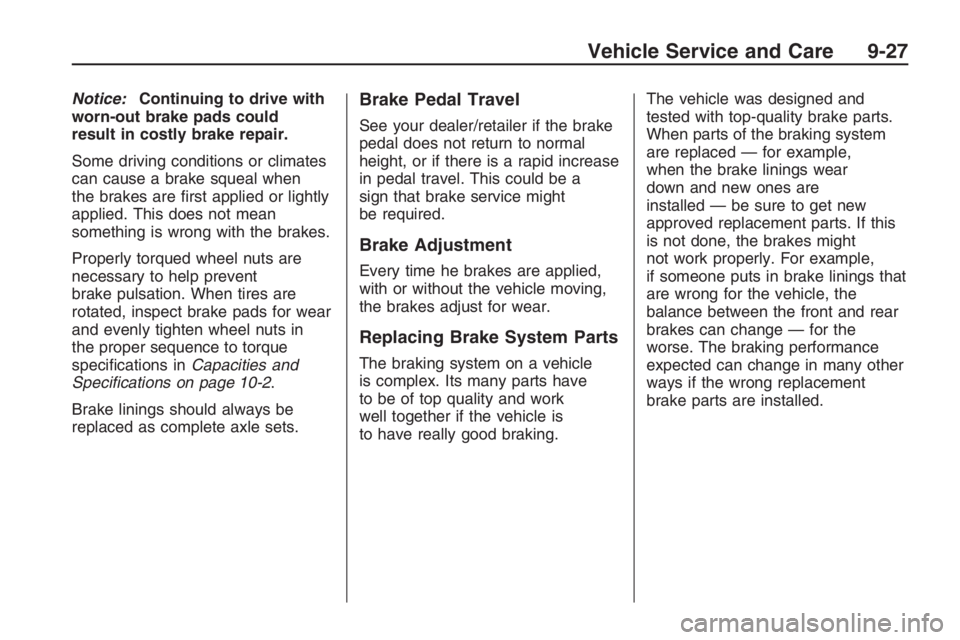2009 PONTIAC G8 height
[x] Cancel search: heightPage 8 of 356

Head Restraints
The front seats have adjustable
head restraints in the outboard
seating positions.
The rear seats have head rests in
the outboard seating positions.
They are not adjustable.
{CAUTION
With head restraints that are not
installed and adjusted properly,
there is a greater chance that
occupants will suffer a neck/spinal
injury in a crash. Do not drive
until the head restraints for all
occupants are installed and
adjusted properly.Adjust the head restraint so that the
top of the restraint is at the same
height as the top of the occupant’s
head. This position reduces the
chance of a neck injury in a crash.Pull the head restraint up to raise it.
To lower the head restraint, press
the button, located on the top of
the seatback, and push the
restraint down.
Push down on the head restraint
after the button is released to make
sure that it is locked in place.
The vehicle’s head restraints are not
designed to be removed.
1-4 Seats and Restraints
Page 36 of 356

Adding Equipment to
Your Airbag-Equipped
Vehicle
Q:Is there anything I might add to
or change about the vehicle
that could keep the airbags
from working properly?
A:Yes. If you add things that
change the vehicle’s frame,
bumper system, height, front end
or side sheet metal, they may
keep the airbag system from
working properly. Changing or
moving any parts of the front
seats, safety belts, the airbag
sensing and diagnostic module,
steering wheel, instrument panel,
roof-rail airbag modules, the
inside rearview mirror, ceiling
headliner or pillar garnish trim,
front sensors, or airbag wiring
can affect the operation of the
airbag system.In addition, the vehicle has a
passenger sensing system for the
right front passenger position,
which includes sensors that are
part of the passenger’s seat.
The passenger sensing system
may not operate properly if the
original seat trim is replaced
with non-GM covers, upholstery
or trim, or with GM covers,
upholstery or trim designed for
a different vehicle. Any object,
such as an aftermarket seat
heater or a comfort enhancing
pad or device, installed under or
on top of the seat fabric, could
also interfere with the operation of
the passenger sensing system.
This could either prevent proper
deployment of the passenger
airbag(s) or prevent the
passenger sensing system from
properly turning off the passenger
airbag(s). SeePassenger
Sensing System on page 1-27.If you have any questions about
this, you should contact Customer
Assistance before you modify
your vehicle. The phone numbers
and addresses for Customer
Assistance are in Step Two of the
Customer Satisfaction Procedure
in this manual. SeeCustomer
Satisfaction Procedure on
page 12-1.
Q:Because I have a disability,
I have to get my vehicle
modi�ed. How can I �nd out
whether this will affect my
airbag system?
A:If you have questions, call
Customer Assistance.
The phone numbers and
addresses for Customer
Assistance are in Step Two
of the Customer Satisfaction
Procedure in this manual.
SeeCustomer Satisfaction
Procedure on page 12-1.
1-32 Seats and Restraints
Page 38 of 356

Child Restraints
Older Children
Older children who have outgrown
booster seats should wear the
vehicle’s safety belts.
The manufacturer’s instructions that
come with the booster seat, state
the weight and height limitations forthat booster. Use a booster seat
with a lap-shoulder belt until
the child passes the below �t test:
Sit all the way back on the
seat. Do the knees bend at the
seat edge? If yes, continue.
If no, return to the booster seat.
Buckle the lap-shoulder belt.
Does the shoulder belt rest
on the shoulder? If yes, continue.
If no, try using the rear safety
belt comfort guide. See “Rear
Safety Belt Comfort Guides”
underLap-Shoulder Belt on
page 1-14for more information.
If the shoulder belt still does
not rest on the shoulder,
then return to the booster seat.
Does the lap belt �t low and snug
on the hips, touching the thighs?
If yes, continue. If no, return
to the booster seat.
Can proper safety belt �t be
maintained for the length of
the trip? If yes, continue. If no,
return to the booster seat.
Q:What is the proper way to
wear safety belts?
A:An older child should wear a
lap-shoulder belt and get the
additional restraint a shoulder
belt can provide. The shoulder
belt should not cross the face or
neck. The lap belt should �t
snugly below the hips, just
touching the top of the thighs.
This applies belt force to
the child’s pelvic bones in a
crash. It should never be worn
over the abdomen, which
could cause severe or even fatal
internal injuries in a crash.
Also see “Rear Safety Belt Comfort
Guides” underLap-Shoulder Belt
on page 1-14.
According to accident statistics,
children and infants are safer when
properly restrained in a child restraint
system or infant restraint system
secured in a rear seating position.
1-34 Seats and Restraints
Page 42 of 356

Q:What are the different types of
add-on child restraints?
A:Add-on child restraints, which are
purchased by the vehicle’s
owner, are available in four basic
types. Selection of a particular
restraint should take into
consideration not only the child’s
weight, height, and age but also
whether or not the restraint will be
compatible with the motor vehicle
in which it will be used.
For most basic types of child
restraints, there are many
different models available.
When purchasing a child
restraint, be sure it is designed
to be used in a motor vehicle.
If it is, the restraint will have
a label saying that it meets
federal motor vehicle safety
standards.The restraint manufacturer’s
instructions that come with the
restraint state the weight and
height limitations for a particular
child restraint. In addition, there
are many kinds of restraints
available for children with
special needs.
{CAUTION
To reduce the risk of neck and
head injury during a crash, infants
need complete support. This is
because an infant’s neck is not
fully developed and its head
weighs so much compared with
the rest of its body. In a crash,
an infant in a rear-facing child
restraint settles into the restraint,
so the crash forces can be
distributed across the strongest
part of an infant’s body, the back
and shoulders. Infants should
always be secured in rear-facing
child restraints.
{CAUTION
A young child’s hip bones are still
so small that the vehicle’s regular
safety belt may not remain low
on the hip bones, as it should.
Instead, it may settle up around
the child’s abdomen. In a crash,
the belt would apply force on a
body area that is unprotected by
any bony structure. This alone
could cause serious or fatal
injuries. To reduce the risk of
serious or fatal injuries during a
crash, young children should
always be secured in appropriate
child restraints.
1-38 Seats and Restraints
Page 231 of 356

Notice:Continuing to drive with
worn-out brake pads could
result in costly brake repair.
Some driving conditions or climates
can cause a brake squeal when
the brakes are �rst applied or lightly
applied. This does not mean
something is wrong with the brakes.
Properly torqued wheel nuts are
necessary to help prevent
brake pulsation. When tires are
rotated, inspect brake pads for wear
and evenly tighten wheel nuts in
the proper sequence to torque
speci�cations inCapacities and
Specifications on page 10-2.
Brake linings should always be
replaced as complete axle sets.Brake Pedal Travel
See your dealer/retailer if the brake
pedal does not return to normal
height, or if there is a rapid increase
in pedal travel. This could be a
sign that brake service might
be required.
Brake Adjustment
Every time he brakes are applied,
with or without the vehicle moving,
the brakes adjust for wear.
Replacing Brake System Parts
The braking system on a vehicle
is complex. Its many parts have
to be of top quality and work
well together if the vehicle is
to have really good braking.The vehicle was designed and
tested with top-quality brake parts.
When parts of the braking system
are replaced — for example,
when the brake linings wear
down and new ones are
installed — be sure to get new
approved replacement parts. If this
is not done, the brakes might
not work properly. For example,
if someone puts in brake linings that
are wrong for the vehicle, the
balance between the front and rear
brakes can change — for the
worse. The braking performance
expected can change in many other
ways if the wrong replacement
brake parts are installed.
Vehicle Service and Care 9-27
Page 233 of 356

The vehicle should:
Be placed so the headlamps
are 25 ft. (7.6 m) from a light
colored wall.
Have all four tires on a perfectly
level surface which is level all
the way to the wall.
Be placed so it is at a right angle
to the wall.
Not have any snow, ice, or
mudonit.
Be fully assembled and all other
work stopped while headlamp
aiming is being done.
Have a full tank of fuel and one
person or 160 lbs (75 kg) on
the driver seat.
Have all tires properly in�ated.
Headlamp aiming is done with
the vehicle’s low-beam headlamps.
The high-beam headlamps will
be correctly aimed if the low-beam
headlamps are aimed properly.To adjust the vertical aim on the
headlamps:
1. Open the hood.Hood Release
on page 9-5.
2. Locate the aim dot on the lens of
the low-beam headlamp.
3. Record the distance from the
ground to the aim dot on the
low-beam headlamp.4. At the wall, measure from the
ground upward (A) to the
recorded distance from Step 3
and mark it.
5. Draw or tape a horizontal line (B)
on the wall the width of the
vehicle at the height of the
mark in Step 4.
Vehicle Service and Care 9-29
Page 247 of 356

(A) Tire Size:The tire size is
a combination of letters and
numbers used to de�ne a
particular tire’s width, height,
aspect ratio, construction
type, and service description.
See the “Tire Size” illustration
later in this section for more
detail.(B) TPC Spec (Tire
Performance Criteria
Speci�cation)
:Original
equipment tires designed to
GM’s speci�c tire performance
criteria have a TPC speci�cation
code molded onto the sidewall.
GM’s TPC speci�cations meet
or exceed all federal safety
guidelines.
(C) DOT (Department of
Transportation)
:The
Department of Transportation
(DOT) code indicates that
the tire is in compliance with
the U.S. Department of
Transportation Motor Vehicle
Safety Standards.
(D) Tire Identi�cation Number
(TIN)
:The letters and numbers
following DOT (Department
of Transportation) code is the
Tire Identi�cation Number (TIN).
The TIN shows the manufacturer
and plant code, tire size, and
date the tire was manufactured.The TIN is molded onto both
sides of the tire, although only
one side may have the date
of manufacture.
(E) Tire Ply Material
:The type
of cord and number of plies
in the sidewall and under
the tread.
(F) Uniform Tire Quality
Grading (UTQG)
:Tire
manufacturers are required to
grade tires based on three
performance factors: treadwear,
traction, and temperature
resistance. For more information
seeUniform Tire Quality
Grading on page 9-62.
(G) Maximum Cold In�ation
Load Limit
:Maximum load
that can be carried and the
maximum pressure needed to
support that load.
Passenger (P-Metric) Tire
Example
Vehicle Service and Care 9-43
Page 248 of 356

(A) Temporary Use Only:The
compact spare tire or temporary
use tire has a tread life of
approximately 3,000 miles
(5 000 km) and should not be
driven at speeds over 65 mph
(105 km/h). The compact
spare tire is for emergency use
when a regular road tire has
lost air and gone �at. If your
vehicle has a compact spare tire.SeeCompact Spare Tire on
page 9-83andIf a Tire
Goes Flat on page 9-66.
(B) Tire Ply Material
:The type
of cord and number of plies
in the sidewall and under
the tread.
(C) Tire Identi�cation Number
(TIN)
:The letters and numbers
following the DOT (Department
of Transportation) code is
the Tire Identi�cation Number
(TIN). The TIN shows the
manufacturer and plant code,
tire size, and date the tire
was manufactured. The TIN is
molded onto both sides of
the tire, although only one side
may have the date of
manufacture.
(D) Maximum Cold In�ation
Load Limit
:Maximum load
that can be carried and
the maximum pressure needed
to support that load.(E) Tire In�ation
:The
temporary use tire or compact
spare tire should be in�ated
to 60 psi (420 kPa). For
more information on tire
pressure and in�ation see
Inflation - Tire Pressure on
page 9-49.
(F) Tire Size
:A combination of
letters and numbers de�ne a
tire’s width, height, aspect ratio,
construction type, and service
description. The letter T as
the �rst character in the tire size
means the tire is for temporary
use only.
(G) TPC Spec (Tire
Performance Criteria
Speci�cation)
:Original
equipment tires designed to
GM’s speci�c tire performance
criteria have a TPC speci�cation
code molded onto the sidewall.
GM’s TPC speci�cations meet
or exceed all federal safety
guidelines.
Compact Spare Tire Example
9-44 Vehicle Service and Care